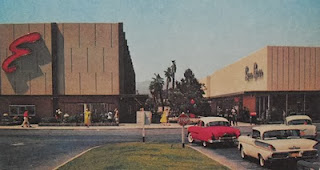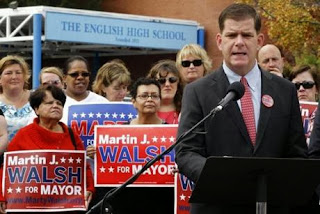The Boston Public Schools is in the midst of many changes. In the next couple years, the ELA and math MCAS exam will be replaced with the PARCC test based on the new Common Core standards. A new teacher evaluation system has gone into effect that gives principals more discretion in dismissing teachers that they rate unsatisfactory, however, concerns have also been raised about its race and age bias. BPS has instituted new policies that give principals more flexibility in hiring teachers. A new school assignment system will go into effect that will modify school choice using a home-based model, but will ultimately limit school choice for most parents and could result in more race and class segregation. The Boston School Department will physically move from Court Street downtown to the renovated Ferdinand Building in Dudley Square (see images below). With Marty Walsh taking office as the first new mayor in 20 years, there will also be major changes in the leadership of the Boston Public Schools, including a new Boston school superintendent.
During this time of change, the choice of the next school superintendent is crucial. On the one hand, Marty Walsh could choose a market-based education reformer; someone who would expand the number of charter schools, push for merit pay, develop a contentious relationship with the teachers union, and expand programs like Teach for America in BPS. In fact, in an interview about a month ago, he said he would "absolutely consider" his former mayoral opponent John Connolly for superintendent (a candidate who generally supported these education positions). Although this appeared to be merely a verbal consolation for his former rival, it resulted in media buzz, as well as push back from some Walsh voters, who found John Connolly's market-based education reform vision and donors troubling.
On the other hand, Marty Walsh could choose a proven leader with experience as an educator to improve, rather than simply reform, the Boston Public Schools. He could follow the lead of progressive New York City mayor-elect (and Massachusetts native) Bill de Blasio, who will appoint on Monday Carmen Fariña as the next NYC superintendent. Fariña is a former Brooklyn teacher and district leader who agrees with de Blasio's stance that there is an excessive emphasis on standardized testing and that market-based education ideas, including the expansion of charter schools, have not improved the New York City public schools. Although I do not have a specific list of superintendent candidates, I do offer the following three suggestions for Marty Walsh's selection of the next superintendent.
Avoid Educational Charlatans
First, do not choose a self-proclaimed education reformer or someone who professes to "turnaround" urban districts. An educational charlatan is someone who falsely claims to have a special knowledge about education, when they do not. Marty Walsh should avoid any superintendent candidates that promise radical change or rapid results. This is usually a sign that the prospective superintendent is overly ideological and usually ill-informed on school improvement (which research shows that meaningful school change almost always takes significant time). These candidates will make lofty promises that they cannot keep, and worse, their promises will often result in greater school inequity and corporate profiteering. John Connolly ran almost exclusively on his education platform, which included decentralizing the school system and increasing charter schools. He highlighted his contentious relationship with the Boston Teachers Union. These reforms would be major set backs for, despite its high rate of poverty, one of the best urban school systems in the country. The Boston Public Schools need a superintendent committed to sustaining the the progress the system has made over the past two decades and someone who will intentionally focus support and resources on the schools that are struggling the most. This strategy has had relative success at the William Monroe Trotter (where I have done work as a professor at Boston University) and Orchard Gardens. The voters of Boston chose Marty Walsh, which was a clear rejection of John Connolly's market-based education reform plan.
Experience and Qualification Matter
Local Knowledge Can Make the Difference
Third, there are many qualified candidates inside and outside the Boston Public Schools, with knowledge of Boston or similar districts, that would make excellent superintendents. Despite saying he will only look outside BPS during the campaign, Marty Walsh should not rule out some of the current BPS leadership. Educational leaders who have spent time in the district may have important insider knowledge that is necessary for meaningful improvement in the district. They will understand BPS's students and families well, and unlike outsiders, not be under the false impression that the Boston school system is failing. They will know when to give principal's more autonomy over their schools and when to require more involvement from the central office. When looking outside of the district, Marty Walsh should consider superintendents of other Massachusetts urban districts and successful school districts nationwide of comparable size and demographics (It is a better idea to look in San Diego or Austin, rather than New Orleans or Chicago). It would be smart to look at high-performing urban school districts that are often overlooked by the media, including Brockton (MA), Framingham (MA), Union City (NJ), Charlotte-Mecklenburg (NC), Montgomery County (MD), and Cincinnati (OH). Candidates who previously or presently lead these districts will have a strong understanding of sustainable educational change and be leery of rapid and dramatic system-wide reform, especially those that have become fashionable with the market-based reformers. As Boston College professors Dennis Shirley and Andy Hargreaves recently pointed out, the most successful school systems do not have "policies supporting fast-track teacher certification programs or salary bonuses for teachers who boost test scores. None have systems of sanctions for struggling schools with rotations of principals and staff in and out that erode trust and destroy community. None set up win-lose competitions among neighboring schools. Instead, teachers and schools in challenging circumstances receive additional supports, including from more successful schools, so that they can identify problems quickly and resolve them."
For now, the waiting game continues to see who mayor-elect Marty Walsh will appoint and what he envisions for the future of the Boston Public Schools...
(Top: Court Street, which is the current headquarters of the Boston Public Schools. Bottom: The Ferdinand Building, a former department store that is being renovated and will soon be the new headquarters for the Boston Public Schools.)










































